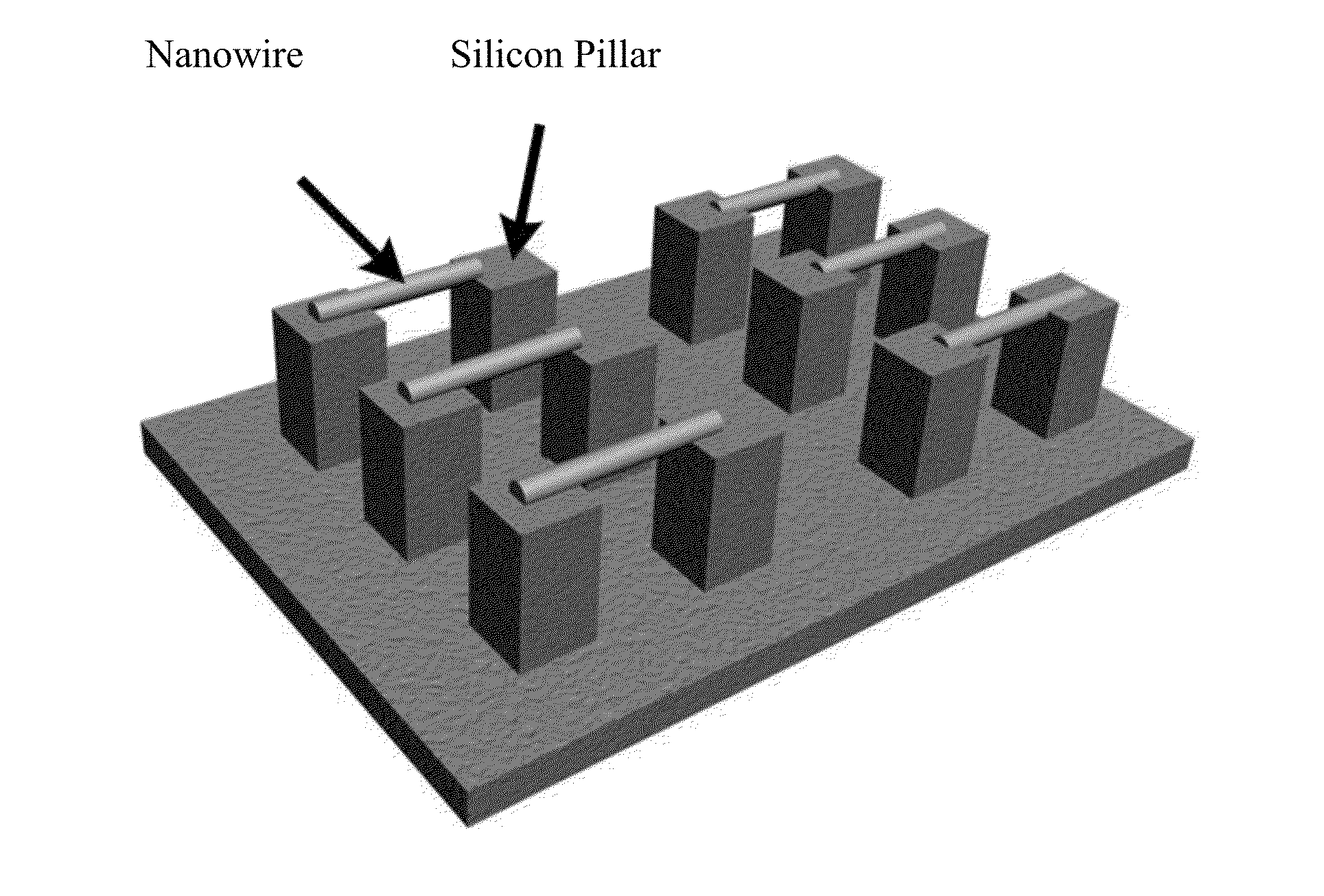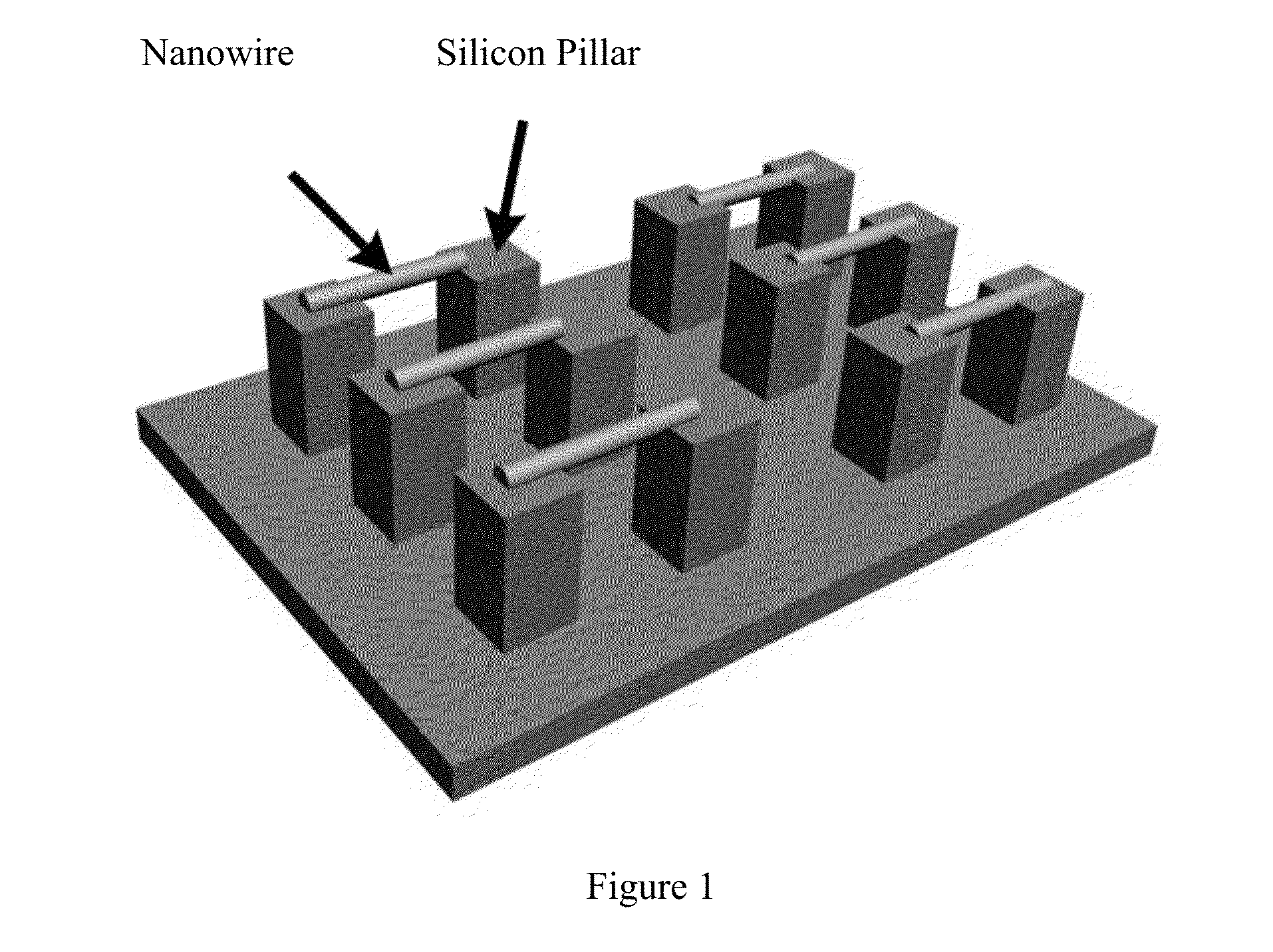Method for forming microelectrode-pair arrays on silicon substrate surface with hydrophobic silicon pillars
- Summary
- Abstract
- Description
- Claims
- Application Information
AI Technical Summary
Benefits of technology
Problems solved by technology
Method used
Image
Examples
example 1
[0034](1) Immerse a silicon wafer with a hydrophilic silicon pillar array on the surface prepared through a laser etching process (the interval between adjacent silicon pillars in the array is 15 μm, the silicon pillars are in micrometer-level diameter) into 1 wt % ethanol solution of fluorooctylsilane, and control the silicon wafer and the molecules of fluorooctylsilane to have grafting reaction for 12 h so that the surface of the silicon wafer is modified by the molecules of fluorooctylsilane, to obtain a silicon wafer that contains a hydrophobic silicon pillar array (the silicon pillars in the array is in micrometer-level diameter);
[0035](2) Utilize gravity action to drive 1 wt % water solution of polyvinyl alcohol adulterated with nanometer copper particles in 10 nm particle size (the mass ratio of polyvinyl alcohol to nanometer copper particles is 1:5) to flow across the top surface of the hydrophobic silicon pillar array on the silicon wafer obtained in step (1) at 5 cm / s cons...
example 2
[0038](1) Immerse a silicon wafer with a hydrophilic silicon pillar array on the surface prepared through a masking and exposure process (the interval between adjacent silicon pillars in the array is 1 μm, the silicon pillars are in micrometer-level diameter) into 13% (mass percent) acetone solution of fluorodecylsilane, and control the silicon wafer and the molecules of fluorodecylsilane to have grafting reaction for 1 h so that the surface of the silicon wafer is modified by the molecules of fluorodecylsilane, to obtain a silicon wafer that contains a hydrophobic silicon pillar array (the silicon pillars in the array is in micrometer-level diameter);
[0039](2) Utilize adhesion induction technique to induce 1×10−9% (mass percent) water solution of poly(3,4-ethylenedioxythiophene) adhered to ordinary cotton rodlets to flow across the top surface of the hydrophobic silicon pillar array on the silicon wafer obtained in step (1) at 0.1 cm / s constant flow rate in a specific direction; as...
example 3
[0040](1) Immerse a silicon wafer with a hydrophilic silicon pillar array on the surface prepared through a wet chemical erosion process (the interval between adjacent silicon pillars in the array is 30 μm, the silicon pillars are in micrometer-level diameter) into 25% (mass percent) dimethyl sulfoxide solution of fluorododecylsilane, and control the silicon wafer and the molecules of fluorododecylsilane to have grafting reaction for 24 h so that the surface of the silicon wafer is modified completely by the molecules of fluorododecylsilane, to obtain a silicon wafer that contains a hydrophobic silicon pillar array (the silicon pillars in the array is in micrometer-level diameter);
[0041](2) Utilize magnetic field effect to drive 20% (mass percent) water solution of polystyrene sulfonate-poly(3,4-ethylenedioxythiophene) (PSS-PEDOT) to flow across the top surface of the hydrophobic silicon pillar array on the silicon wafer obtained in step (1) at a constant flow rate in a specific dir...
PUM
| Property | Measurement | Unit |
|---|---|---|
| Fraction | aaaaa | aaaaa |
| Fraction | aaaaa | aaaaa |
| Time | aaaaa | aaaaa |
Abstract
Description
Claims
Application Information
 Login to View More
Login to View More - R&D
- Intellectual Property
- Life Sciences
- Materials
- Tech Scout
- Unparalleled Data Quality
- Higher Quality Content
- 60% Fewer Hallucinations
Browse by: Latest US Patents, China's latest patents, Technical Efficacy Thesaurus, Application Domain, Technology Topic, Popular Technical Reports.
© 2025 PatSnap. All rights reserved.Legal|Privacy policy|Modern Slavery Act Transparency Statement|Sitemap|About US| Contact US: help@patsnap.com


